
Phase and Time 3
![]() Text to speech – TestHiFi blog: Phase and Time 3
Text to speech – TestHiFi blog: Phase and Time 3
Phase and Time – Time Domain Response, Step Response
In my first blog „Phase and Time 1“ I focused on amplitude and phase shown as functions of frequency.
In this last blog about phase and time domain issues of loudspeakers I want to transfer our view into the time domain.
Two excitation signals are regularely used to show the time domain answer of loudspeakers:
Impulse response and step response. Since I find it easier to identify things with step response displays I will use it here.
SPL plots are scaled to 2.83 V sensitivity at 61 cm distance. To calculate 1m sensitivity, subtract 4 dB (some nearfield effect).
Remark: measurements are not made with step signals, but usually logarithmic sweeps. From this the step response is calulated.
The test loudspeaker
The top picture shows the mid- and high frequency section of that loudspeaker.
I measured the high-mid-portion of a semi-active loudspeaker standing around in my workshop. Therefore, no bass response seen.
This speaker uses the woofer of the still popular Yamaha NS10 as a midrange. Low mass, high sensitivity, no upper midrange breakup.
Nice woofer – but no bass (if you know the sound of the NS10, I will someday publish a mod for it to achieve more linear SPL).
Made to compare the sound of paper cones with good aluminum ones (my own Tau loudspeakers, using similar LF and HF, but passive).
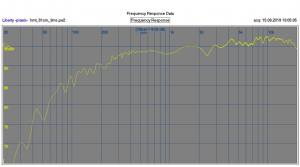
Original MF+HF SPL
SPL vs frequency is ok, smooth enough, and you can see that it needs support from the active woofer even above 1 kHz.
No problem for the very good 10 inch paper cone woofer used.
The fullrange systems sounds nice indeed. Nevertheless I do prefer the lower distortion aluminum midrange.
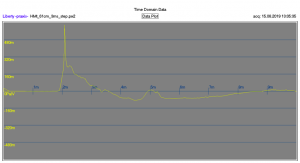
Original MF+HF Step
Of course – as most of my recent designs – near perfect time domain response. H and M respond at the same time – producing only one common peak. There is a nice reason why I choose this woofer as a midrange. After optimizing the cabinet width and midrange position I need only one coil to filter M and one cap for H. Nothing else! Besides an LCR parallel to the speaker to smooth impedance for use with tube amps. Very tube friendly – sensitivity around 92 dB (with woofer) and above 10 ohms everywhere.
Remark: You can clearly see the floor reflexion at around 5 ms.
Now for something more „regular“
I moved the tweeter to the front, as shown on the picture below.
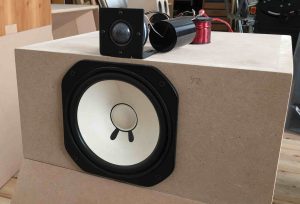
H moved towards cabinet edge
People keep asking me if the „reflection of the HF on the cabinet top does not harm the response“?
See what happens to the SPL of the tweeter moved forward to the cabinet edge (recessed position yellow, forward pos red):
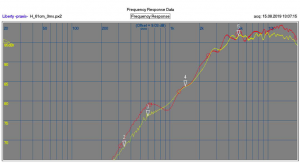
H recessed vs edge position
Getting closer to the mic (61 cm in front of and slightly above the cabinet edge) H gets louder.
But due to loss of radiation impedance and stronger floor reflexions, response is actually less linear.
No sign of reflexions in the original recessed tweeter position!
Unfortunately, the sum of midrange (M) and tweeter (H) is less than optimum, with out-of-phase loss below the crossover.
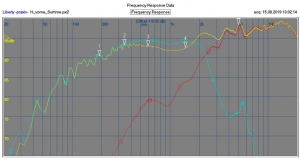
MF+HF summation forward position
But now we can see what nearly all two-way loudspeakers do with the step signal:
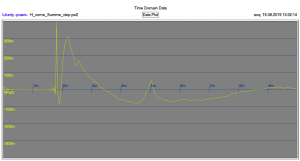
MF+HF forward position step
H step rises around 1.7 ms, M follows after 1.95 ms. Look at the SPL vs frequency plot. Try to guess the filter slope. Estimate the phase difference between M and H at the crossover frequency – to arrive at this „time smear“ 0.2-0.3 ms. Of course, the magnitude of delay between the two peaks depends on the filter and crosssover frequency. Higher order filtering or lower c/o frequency produce larger delays.
Modification
To achieve a better summation of M and H I added a coil across the tweeter, producing a steeper electrically second order network.
Now M and H sum nicely to nearly +6 dB at the crossover frequency.
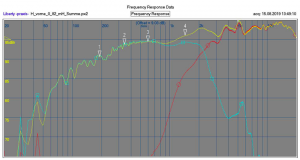
MF+HF forward modified SPL
Of course, step response is even worse than with the original tweeter filter:
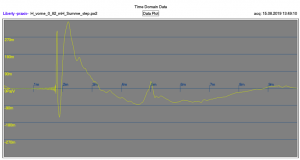
MF+HF forward modified step
This is due to the more complex tweeter network – steeper filter, more time domain ringing.
Let’s look a H playing solo:
H SPL alone (red = original position, cyan = tweeter near front, yellow = modified tweeter near front):
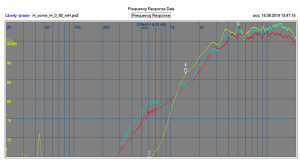
H original vs forward and modified forward position
And the effect of the second order filter on the tweeter step response (cyan = tweeter near front, yellow modified tweeter near front).
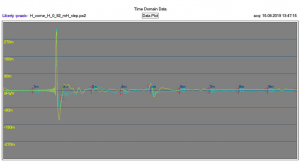
H forward vs modified forward pos step
Due to steeper filtering, more negative ringing amplitude and one more positive cycle.
Fazit
I have been talking about the phase delayed parallel radiation around the crossover frequencies of multiway speakers before.
Here we can see these effects as two step responses separated in time. We can also see that steeper filters tend to produce more time domain ringing.
You can find more step response measurements for example in the pages (and online) of Stereophile magazine.
The perception of loudspeaker sound is very subjective.
See a nice article about how different people may listen to the same signal here.
And another, very recent (have a look, horn fans!) article. See John Atkinsons remark about time domain issues below the step response in the measurement section of this Klipschhorn test in Stereophile.